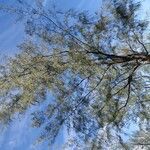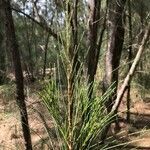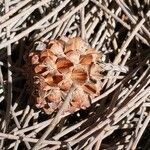Trees monoecious, to 35 m tall, not suckering from roots. Trunk straight, to 70 cm d.b.h.; crown conical; bark scaly, adaxially red-brown on old trees. Ultimate branchlets usually pendu-lous, grayish green, 10-27 cm × 0.8-0.9 mm; articles (2.5-)4-9 mm. Leaves erect and appressed to branchlets, (6 or)7(or 8) per whorl, lanceolate or triangular, 1-3 mm. Male inflorescences1-4 cm. Cones ellipsoid, 1.2-2.5 cm, grayish green or yellowish brown tomentose when young, glabrous at maturity, base and apex truncate to obtuse; apex of bracteoles slightly obtuseor acute. Samaras 5-8 mm including wing. Fl. Apr-May, fr. Jul-Oct. 2n = 18, 20*.
Monoecious tree 6–35 m high. Bark scaly, grey-brown to black. New shoots with teeth erect. Branchlets drooping, to 30 cm long; articles 5–13 mm long, 0.5–1.0 mm diam.; furrows usually densely pubescent; phyllichnia angular or occasionally flat in older growth, glabrous or pubescent; teeth 7 or 8, occasionally 6, erect (rarely spreading in New Guinea), 0.3–0.8 mm long, not marcescent. Male spikes 0.7–4 cm long, 7–11.5 whorls per cm; anther 0.6–0.8 mm long. Cones sparsely pubescent to tomentose; peduncle 3–13 mm long; cone body 10–24 mm long, 9–13 mm diam.; bracteoles acute. Samara 6–8 mm long.
Male inflorescences abundant on deciduous branchlets (rare on persistent branches), 10–30(40) x 1.2–2 mm. (width excluding exserted anthers), cylindrical, tapering gradually into a short sterile basal part; whorls of bracts 15–25; bracts c. 7 per whorl, fewer near the base, appressed, 1.1–1.8 x 0.4–0.5 mm., pubescent outside; bracteoles 0.7–1 x 0.3 mm., ovate, acute, erose-dentate-ciliate in upper one-third; perianth segments 2, up to 0.7 x 0.4 mm., rounded, membranous; filaments exserted by 1.5 mm.; anthers 0.8–1 mm. long, brownish.
A small tree. It grows 5-10 m high. It can spread to 3-10 m wide. Often there are several stems. The bark is rough and brown. It peels off in long strips. The branches hang downwards. There are 6-8 angled needles. The leaves hang downwards. The leaves are reduce to tiny scales on long fine branches. The flowers are separately male and female. The male are in small spikes and the female in round clusters. The fruit are brown round, woody cones. They are 1.5-2 cm across.
Infructescences 8–17(25) x 10–16 mm., shortly cylindrical or subglobose, ± flattened at the apex, (6)8–9(12) whorls of paired infructescence valves; valve pairs 7–8 per whorl, 1.5–3.2 mm. wide (but smaller and fewer towards apex), valves ± obovate, acute to mucronate, apices projecting by 1.5–3 mm., gap between adjacent pairs 0.5–1 mm. wide, valve backs with 2(3) longitudinal ridges (TAB. 35, fig. 3).
Female inflorescences axillary, toward the apices of younger persistent branches, scattered or densely clustered, often on same branches as male inflorescences; heads 3–5 mm. long, ovoid or subglobose; stalk 3–10 mm. long; bracts as for the male inflorescences; stigmas exserted by 3–4 mm., red.
Deciduous branchlets numerous, especially toward the apices of the persistent branches, (0.4)0.5–0.7 mm. in diam., 7–8-ribbed; scale leaves (6)7–8 per whorl, greenish or straw-coloured, free part c. 0.5–0.7 mm. long, appressed, thinly chartaceous, glabrous, margin ciliate.
Youngest persistent branches with internodes usually 1.5–2.5 mm. long; scale leaves (6)7–8 per whorl, greenish or straw-coloured, united at base into a short tube c. 1 mm. long, free part 2–3 mm. long, much reflexed, thickly chartaceous, pubescent.
Samaras pale brown, dull, 5–7 mm. long, to 1 mm. thick; wing 3.5–4.5 x 2–3 mm. (those from small valves smaller), whitish or pale-brown translucent, longitudinal nerve excurrent into a mucronate curved apex.
Tree up to 25 m tall, monoecious. Branchlets green, slender, deflexed to pendulous. Staminate inflorescences ca. 2 cm long. Infructescences ca. 1-2 cm in diam.
Tree 7–25 m. tall, monoecious; sterns stout, up to c. 30 cm. diam. breast height, sometimes several, bark grey-brown.
Subspecies 2 (1 in the flora): North America; Southeast Asia; s Pacific Islands (e to Tahiti and Samoa); Australia.










